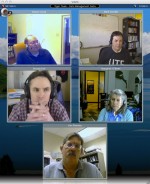May 2010 marked the launch of tiger team Aragorn, a group of LTER volunteers who will help developers at the LTER Network Office (LNO) conceptualize, design, and test the Network Information System (NIS).
Each tiger team — nine in all are planned, hence the team codenames’ correspondence to the characters from Tolkien’s Lord of the Rings novels — oversees a major subsystem of the NIS. The purview of team Aragorn is the Metadata Management suite of NIS software components. Two other teams have come up in recent months to work on the NIS subsystems dedicated to Workflow Management (codename Boromir) and Data Management (codename Frodo), with the remaining six teams scheduled to begin their work at various points over the next year or so.
The term tiger team is borrowed from the defense industry, where specialized teams are assembled to test the security of critical systems. As applied to the NIS the definition, it is more general and refers to “a team set up solely in response to a specific situation or problem while recognizing but not resolving larger-scale and longer-term issues” (source Wikipedia).
The tiger team model was proposed, largely as an outcome of an extensive review of the operational plan of the LNO conducted earlier this year, as a way for key NIS stakeholders (LTER scientists, students, and information managers) to promote community dialog and provide rapid, iterative feedback to the NIS software development effort. Each tiger team typically consists of two to five members from the LTER community who volunteer several hours per month over a span of four to eight months, contributing their scientific, technical, and non-technical expertise. NIS developers based at the Network Office also participate regularly in tiger team meetings and related activities.
Kristin Vanderbilt, Information Manager at Sevilleta LTER, who volunteered for the Aragorn team (Metadata Management) in part to learn about its underlying web services technology, noted: “It’s been valuable to get explanations from the experts.” But her own input has proven useful to the team on a number of occasions, particularly with regard to questions about design choices and how they affect end users. “That’s the part of NIS development that most concerns me — what the information manager user experience will be like,” she said, adding, “I hope scientists are volunteering for the tiger teams to ensure that their needs will be met.”
Duane Costa is the NIS Lead Developer at the LTER Network Office

 Enlarge this image
Enlarge this image